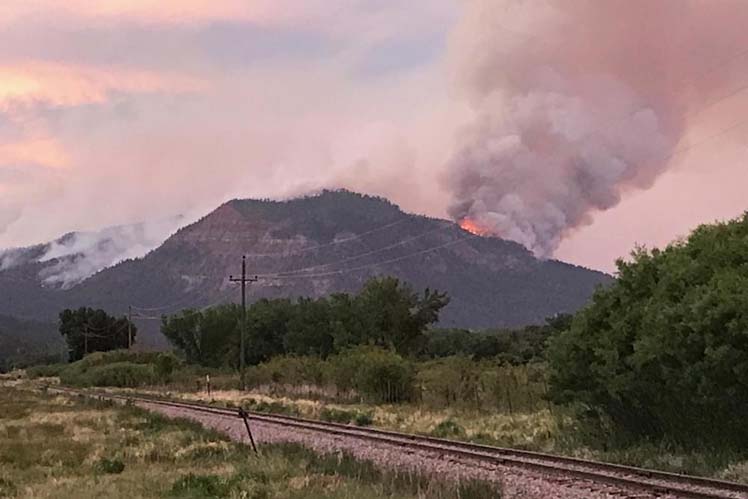

from the 416 Fire in early June - Date/Photographer unknown.
No Escape from Climate Change
Silverton Colorado USA - For long time Southwesterners, this year's low snowfall and high temperatures bring back memories of 2002, a year that seemed to stand as the region's come-to-Jesus climate moment.
The snow cover was thin to nonexistent, even in the high country.
Fields dried up and Lake Powell began its big shrink.
Record-breaking fires burned across the region.
But as the warm spring of 2002 moved into a scorching summer, I wasn't worried.
I lived in Silverton, Colorado, at 9,318 feet in elevation, where extreme drought for everyone else just meant a more pleasant summer for us.
And so, on an early June afternoon in 2002, while the lowlands broiled, I noticed what looked like a puffy cumulonimbus cloud rising up in the gap formed by the Animas River gorge.
It wasn't a cloud at all, but a billowing tower of smoke from what would become known as the Missionary Ridge Fire.
Over the coming weeks the blaze would eat through 73,000 acres of parched scrub oak, aspen, ponderosa pine, and spruce forest, burn 83 structures, and batter the regional economy.
Flash forward to June 2018.
Much like the Missionary Ridge Fire, the 416 Fire has been ripping through forests north of Durango since 1 Jun 2018 sending up roiling clouds of smoke and diminishing the air quality for miles around.
The current fire was sparked almost exactly 16 years after the former in similar vegetation.
This time, though, the flames were no surprise.
We knew that the dry winter of 2018 would usher in an explosive fire season, which is not to say that the region took enough precautions.
During the Missionary Ridge Fire, and in its immediate aftermath, Silverton did not become a destination for refugees fleeing fire, heat, and drought.
To the contrary, despite the fact that the flames never got anywhere near Silverton, the mining-turned-tourist town's economy took the biggest blow of all the region's communities.
This year looks to be no different.
The Durango & Silverton Narrow Gauge Railroad, the primary artery for delivering tourist dollars to Silverton, has suspended service for the month of June because the coal-fired locomotives are a fire hazard.
(In fact, the train is suspected of igniting the 416 Fire, though the official cause remains "unknown.")
One of just two highways connecting Silverton to the outside world has been closed on-and-off, due to the fire, further hampering the ability of tourists to get to the town.
Now, the Forest Service indefinitely closed the 1.8 million acre San Juan National Forest, cutting off mountain bike and hiking trails, campgrounds, and jeep roads, along with a major revenue stream for the entire region's outdoor recreation oriented businesses.
Eventually, the rains will come, and the fire danger will diminish, and television screens will no longer be alight with images of southwestern Colorado's forests engulfed by hellish flames.
But, the pain undoubtedly will resonate through the rest of the summer, just as it did in 2002 after the Missionary Ridge Fire subsided.
Repercussions may still be felt for years to come, too, particularly when it comes to the steam-powered train.
In the wake of the 416 Fire, social media has stoked a movement pushing the railroad to switch to diesel locomotives, or not run at all, during times of extreme fire danger, before a blaze can erupt.
Such suggestions spark fervent push back from train-reliant sectors of the economy and their supporters.
Since diesel locomotives lack the authenticity and aesthetic appeal of their steam-powered cousins, they argue, such a switch could result in fewer passengers and less tourism revenue overall.
"You must be a complete IDIOT," says a representative commenter on Facebook.
"This town is alive because of that steam train! You must be a transplant trust funder to think we don't need the train."
Replace "train" with your local industry of choice, mining say, or oil and gas drilling, and the exchange repeats one that has resounded around the West for decades.
Concerned citizens ask the mining companies to stop polluting the rivers, or the oil companies to plug their methane leaks, or the train to stop spewing sparks, and the industry and its foot soldiers always lash back.
Even minor protective measures, they say, could kill the industry and bring down the whole economy with it.
This sort of short-term thinking, of prioritizing today's bottom line over future environmental or public health, rarely pays off in the long term.
Yesterday's failure to address mining pollution is the Gold King Mine disaster of 2015, and today's unfettered methane leaks are tomorrow's climate change-caused water shortage.
Today's yearning for the authenticity of coal-fired locomotives is tomorrow's economy obliterating mega fire.
Thirty years ago, coal trains could run without consequence through the "asbestos forest" of the San Juan Mountain high country.
The drought of 2002, however, woke up the railroad's owners to a changing world, one in which the ravages of climate change can, and will, affect even a quaint little tourist train and the quaint little town that relies on it.
The railroad adjusted accordingly, having a fire fighting team follow behind each train to extinguish blazes in their infancy.
The 416 Fire, particularly if it is found to have been started by the train, will prove an even more brutal moment of reckoning, a grim reminder that yet more adaptation is needed.
I had my own moment of reckoning following that unusually toasty day back in 2002 when Silverton's economy went up in smoke for the remainder of that summer.
I realized then that Silverton will never become the sanctuary from global warming that I dreamed it would.
This year the point is being driven home.
There is no sanctuary, not really.
In one way or another, the climate catastrophe that we have wrought reaches into every corner of our planet and our lives, even at 9,318 feet.
Jonathan Thompson.
OKthePK Joint Bar Editor: Article abridged slightly.
provisions in Section 29 of the Canadian
Copyright Modernization Act.


